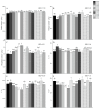Fertilization Improves the Yield of Sapindus saponaria by Affecting Leaf-Soil-Microbial C-N-P Content and Stoichiometry
- PMID: 40364388
- PMCID: PMC12073294
- DOI: 10.3390/plants14091360
Fertilization Improves the Yield of Sapindus saponaria by Affecting Leaf-Soil-Microbial C-N-P Content and Stoichiometry
Abstract
The purpose of this study was to evaluate the effects of different nitrogen (N), phosphorus (P), and potassium (K) fertilization ratios on the carbon (C), N, and P contents and their ecological stoichiometric characteristics in the leaf-soil-microbial system of Sapindus saponaria and elucidate their relationship with yield. A "3414" experimental design was employed in a 6-year-old Sapindus saponaria woodland located in Fujian Province of China. Fourteen N-P-K fertilization treatments with three replicates were established. Leaf, soil, and microbial samples were collected and analyzed for C, N, and P contents. Redundancy Analysis (RDA), Partial Least Squares Path Modeling (PLS-PM), and the entropy-weighted technique of ranking preferences by similarity to optimal solutions (TOPSIS) were utilized to assess the relationships among variables and determine optimal fertilization strategies. It was found through research that different fertilization treatment methods have a significant impact on both the soil nutrient content and the C, N, and P contents of soil microorganisms. Compared with the control group, soil organic C, total N, and total P, and microbial C, N, and P contents increased by 14.25% to 52.61%, 3.90% to 39.84%, 9.52% to 150%, 6.65% to 47.45%, 11.84% to 46.50%, and 14.91% to 201.98%, respectively. Results from Redundancy Analysis (RDA) indicated that soil organic C, total N, and total P exerted a significant influence on the leaf nutrients. PLS-PM demonstrated that fertilization indirectly affected leaf nutrient accumulation and yield by altering soil properties, with soil total phosphorus and leaf phosphorus being key determinants of yield. Additionally, soil microbial entropy impacted yield by regulating microbial biomass stoichiometric ratios. The entropy-weighted TOPSIS model identified the N2P2K2 treatment (600 kg/ha N, 500 kg/ha P, and 400 kg/ha K) as the most effective fertilization strategy. Optimizing N-P-K fertilization ratios significantly enhances leaf nutrient content and soil microbial biomass C, N, and P, thereby increasing Sapindus saponaria yield. This research clarifies the underlying mechanisms through which fertilization exerts an impact on the C-N-P stoichiometry within the leaf-soil-microbial system. Moreover, it furnishes a scientific foundation for the optimization of fertilization management strategies in Sapindus saponaria plantations.
Keywords: C–N–P stoichiometry; Sapindus saponaria; TOPSIS; fertilization; microbial nutrient limitation.
Conflict of interest statement
The research was not conducted with any commercial or financial relationships that could be construed as a potential conflict of interest. We express our heartfelt gratitude to Shuijing Luo for his tending of the plants.
Figures






References
-
- Qi D., Feng F., Lu C., Fu Y. C:N:P Stoichiometry of Different Soil Components after the Transition of Temperate Primary Coniferous and Broad-Leaved Mixed Forests to Secondary Forests. Soil Tillage Res. 2022;216:105260. doi: 10.1016/j.still.2021.105260. - DOI
-
- Xu H., Qu Q., Li G., Liu G., Geissen V., Ritsema C.J., Xue S. Impact of Nitrogen Addition on Plant-Soil-Enzyme C–N–P Stoichiometry and Microbial Nutrient Limitation. Soil Biol. Biochem. 2022;170:108714. doi: 10.1016/j.soilbio.2022.108714. - DOI
Grants and funding
LinkOut - more resources
Full Text Sources

